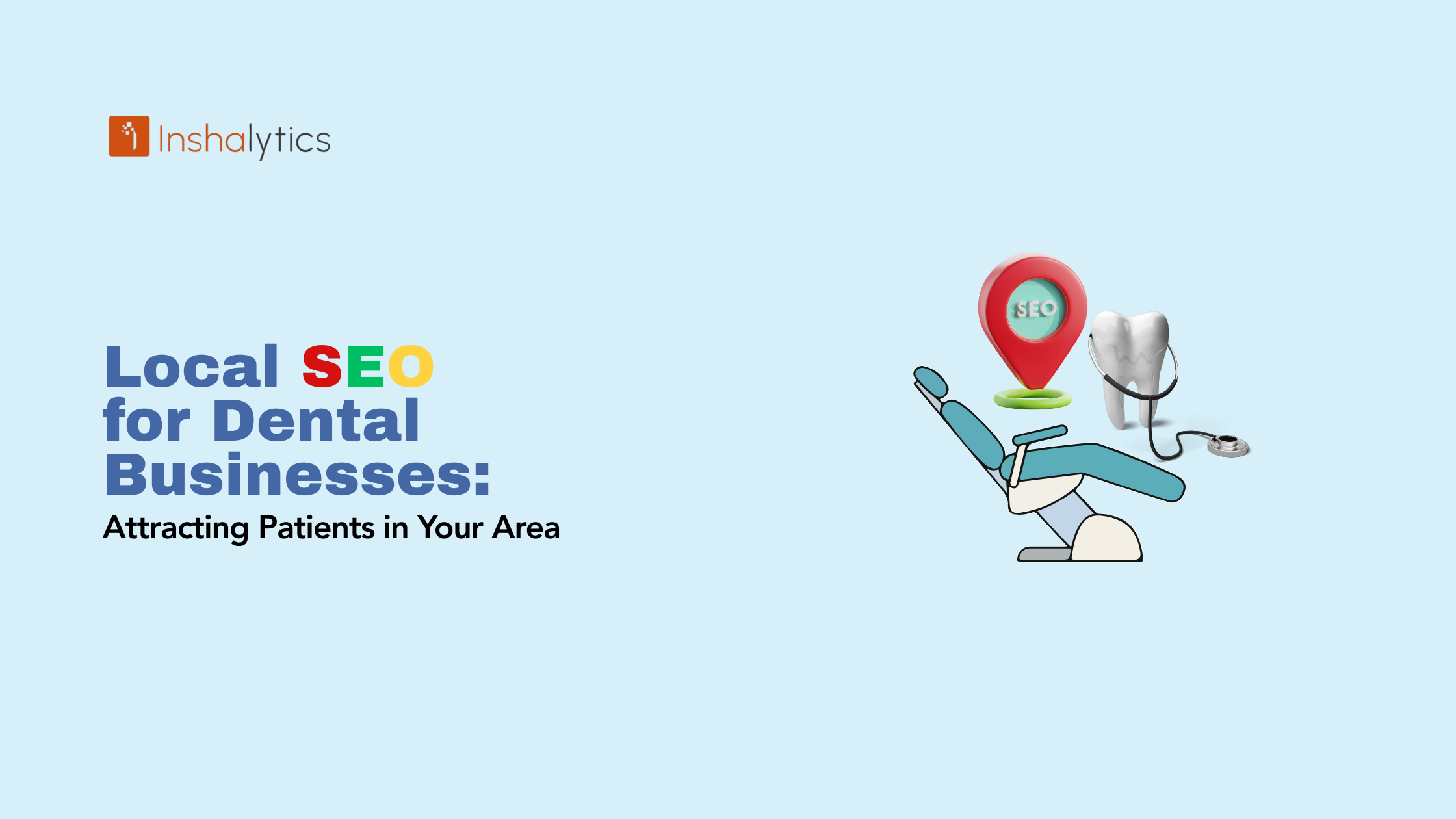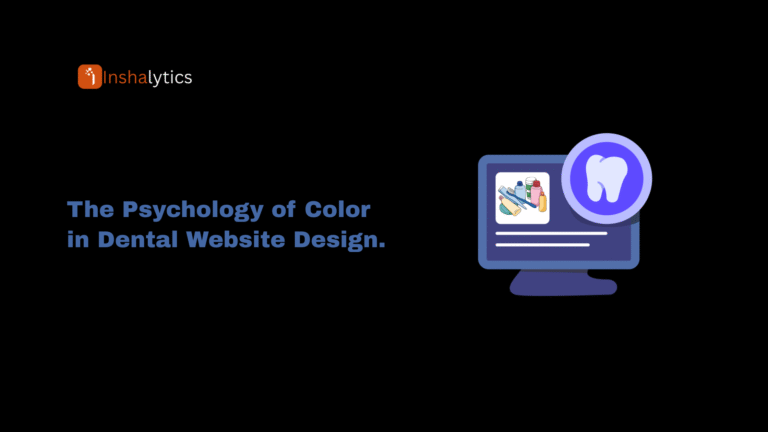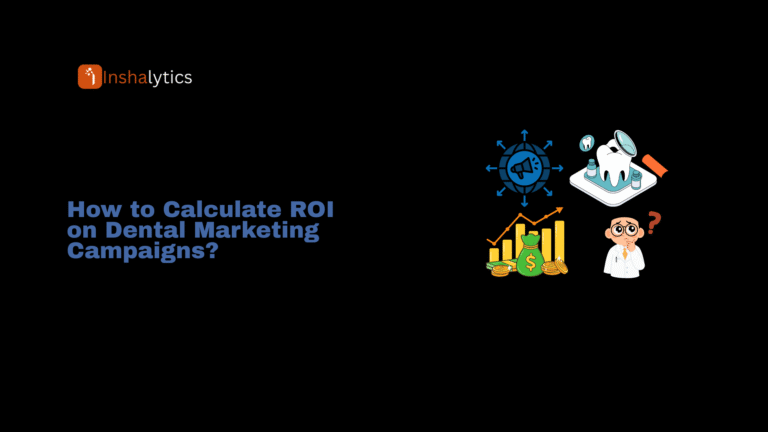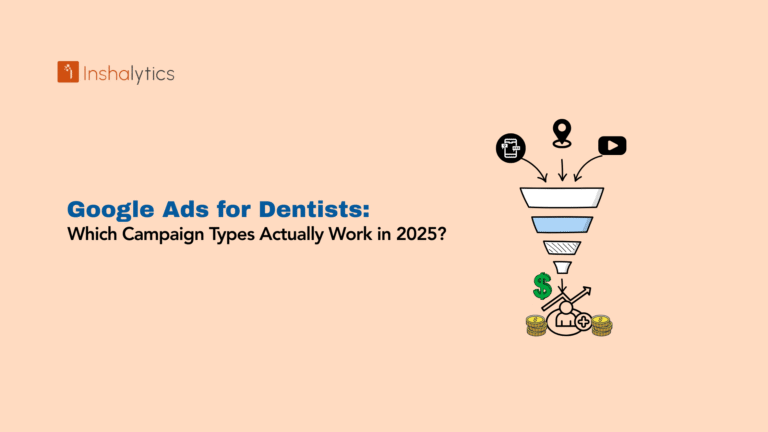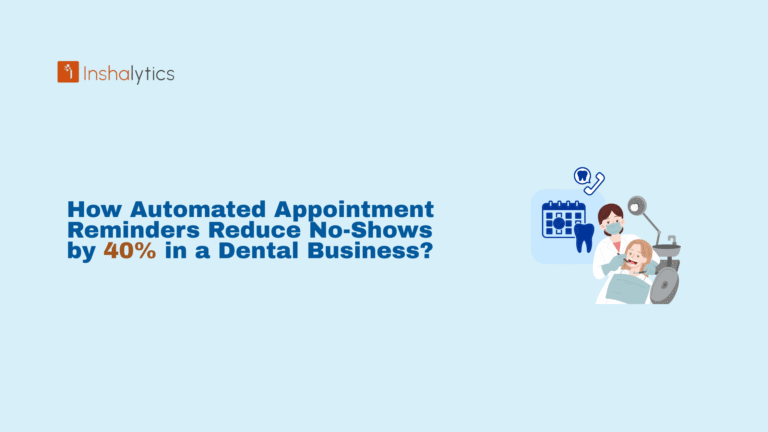When potential patients in your community search for “dentist near me” or “emergency dental care,” does your practice appear at the top of their results? If not, you’re losing valuable appointments to competitors who’ve mastered local SEO.
Bottom Line Up Front: Local SEO helps dental practices dominate search results in their geographic area, attracting high-intent patients actively seeking dental services. By optimizing your Google Business Profile, managing reviews strategically, and creating location-focused content, you can significantly increase patient bookings without spending thousands on advertising.
Why Local SEO Matters for Dental Practices in 2025?
The dental industry has fundamentally shifted toward digital patient acquisition. Today, 78% of local mobile searches result in offline visits within 24 hours, and the majority of those searchers never scroll past the first three results.
Local SEO delivers three critical advantages for dental practices:
Targeted Patient Acquisition: Unlike broad advertising that reaches everyone, local SEO connects you with people actively searching for dental services in your area right now. Someone searching “cosmetic dentist in [your city]” has high intent and is ready to book.
Cost-Effective Growth: While paid advertising requires continuous investment, local SEO generates organic traffic that compounds over time. Once established, your rankings continue driving patient appointments without ongoing ad spend.
Competitive Dominance: The practices ranking in the top three positions capture the majority of clicks and calls. Strong local SEO doesn’t just help you compete it helps you dominate your local market.
The stakes are higher than ever. Patients rarely give second-page results a chance, making top rankings essential for practice growth.
Understanding Local Search: How Patients Find Dentists Online
Before optimizing your presence, you need to understand how patients actually search for dental care and how Google delivers results.
When someone searches for dental services with local intent, Google displays results in three primary formats:
The Local Pack (Map Pack): This prominent section appears near the top of search results, showcasing three local businesses with their Google Business Profile information, ratings, and map locations. This is prime real estate practices appearing here receive significantly more clicks than traditional organic results below.
Organic Search Results: Below the Local Pack, Google displays traditional website listings ranked by relevance and authority. These results favor practices with well-optimized websites containing location-specific content.
Google Maps Results: When patients specifically search on Google Maps or include “near me” in their query, they see an extended list of local dental practices with filtering options.
Understanding patient search behavior reveals important patterns. Most dental searches fall into several categories: emergency needs (“emergency dentist open now”), specific procedures (“dental implants in [city]”), general care (“family dentist near me”), and specialized services (“pediatric dentist [neighborhood]”).
The key insight is that patients use highly specific, location-based searches. They’re not searching for “dental services”—they’re searching for “teeth whitening in downtown Chicago” or “dentist accepting new patients in Austin.”
Google Business Profile Optimization for Dentists
Your Google Business Profile is your digital storefront and the single most important factor in local SEO success. When optimized properly, it can dramatically increase your visibility in local searches.
Setting Up and Claiming Your Profile
If you haven’t claimed your Google Business Profile, that’s your first priority. Visit Google Business Profile, search for your practice name, and claim ownership. If your practice doesn’t appear, you’ll need to create a new listing.
During setup, verify your business through Google’s authentication process typically via postcard, phone, or email. This verification signals to Google that your practice is legitimate and active.
Optimizing Your Business Description and Categories
Your primary category should be “Dentist” or a specialized category like “Cosmetic Dentist,” “Pediatric Dentist,” or “Orthodontist,” depending on your focus. Choose additional categories that accurately represent your services, but avoid over-categorization that might confuse Google’s algorithm.
Craft a compelling business description that incorporates your location and key services naturally. Think of this as your elevator pitch: “Family-focused dental practice serving [neighborhood] for over 15 years. We specialize in cosmetic dentistry, dental implants, and preventive care for patients of all ages.”
Complete every section of your profile meticulously. Add your exact address, phone number (use a local number, not a toll-free line), website URL, and accurate business hours, including holiday schedules. Add attributes like “wheelchair accessible,” “accepts new patients,” or “offers emergency services” to improve matching with patient searches.
Managing Posts and Updates
Google Business Profile posts appear directly in your listing and keep your profile active. Share practice updates, dental health tips, service promotions, and community involvement. Post consistently at least twice per month to signal active management.
Upload high-quality photos regularly. Include images of your office exterior and interior, team members, equipment, and happy patients (with permission). Practices with more photos receive significantly more engagement than those with minimal visuals.
Enable messaging to let patients contact you directly from your Google listing. Quick response times to messages improve your visibility and conversion rates.
Local Keyword Research and Targeting for Dental Practices
Ranking for the right keywords means understanding exactly how your ideal patients search for dental services in your area.
Service-Specific Keywords
Start by identifying your core services and adding location modifiers. Instead of just targeting “dental implants,” you want “dental implants in [city],” “implant dentist near [neighborhood],” or “affordable dental implants [city].”
Create a comprehensive keyword list covering all your services with local variations: teeth whitening, root canal therapy, dental crowns, orthodontics, veneers, emergency dental care, pediatric dentistry, and wisdom teeth removal.
Use keyword research tools like SEMrush, Ahrefs, or Google’s Keyword Planner to discover search volume and competition levels. Look for the sweet spot: keywords with decent search volume but manageable competition.
Emergency and High-Intent Keywords
Emergency-related searches convert at dramatically higher rates because they represent an immediate need. Optimize specifically for terms like “emergency dentist near me,” “dentist open Saturday,” “same-day dental appointments,” and “toothache relief [city].”
High-intent modifiers indicate patients ready to book: “accepting new patients,” “dental insurance accepted,” “affordable,” “best,” and “top-rated.” Incorporate these naturally into your content.
Neighborhood and Geo-Targeted Terms
Don’t just target your city target specific neighborhoods within your service area. Someone in Beacon Hill searching for a dentist is more likely to search “Beacon Hill dentist” than “Boston dentist.”
Create a list of all neighborhoods, suburbs, and nearby communities you serve. Reference these locations naturally throughout your website content, especially on service pages and blog posts.
Long-tail keywords longer, more specific phrases often have lower competition and higher conversion rates. “Family dentist accepting Medicaid in South Austin” is more specific and actionable than just “Austin dentist.”
Managing Online Reviews to Boost Local Rankings
Online reviews are simultaneously a trust signal for patients and a powerful ranking factor for search engines. Your review strategy can make or break your local SEO success.
Generating Patient Reviews Systematically
Don’t leave reviews to chance. Implement a systematic process for requesting feedback from satisfied patients. The optimal time to ask is within 24-48 hours after a positive appointment, when the experience is fresh.
Make the review process effortless. Send follow-up emails or text messages with direct links to your Google Business Profile review page. Some practices include review request cards at checkout or display QR codes that link directly to their review page.
Train your front desk team to mention reviews naturally: “If you had a great experience today, we’d appreciate it if you could share your feedback on Google. It really helps other patients find us.”
Never incentivize reviews with discounts or rewards this violates Google’s policies and can result in penalties. Focus on making the patient experience so exceptional that reviews happen naturally.
Responding to Reviews Professionally
Respond to every review, positive and negative. Thank patients who leave positive feedback with personalized responses that mention specific details when possible: “Thank you for trusting us with your dental implant procedure, Sarah! We’re thrilled you’re happy with the results.”
For negative reviews, respond quickly and professionally. Acknowledge their concerns, apologize for any shortcomings, and offer to resolve the issue offline. Never argue publicly or get defensive your response is visible to future patients.
A thoughtful response to negative feedback can actually improve your reputation by demonstrating accountability and commitment to patient satisfaction.
Leveraging AI for Review Management
Modern review management platforms use AI to streamline the entire process. These tools automatically send review requests, analyze sentiment across all reviews, alert you to negative feedback requiring immediate attention, and even suggest response templates.
AI-powered sentiment analysis helps you identify trends in patient feedback, revealing operational strengths to emphasize and weaknesses to address before they become recurring complaints.
NAP Consistency and Local Citations
NAP stands for Name, Address, and Phone Number the foundational data that search engines use to verify your business’s legitimacy and location.
Why Consistency Matters: Search engines cross-reference your NAP information across hundreds of websites. Inconsistencies create confusion and can harm your rankings. If your website says “123 Main St.” but your Google listing says “123 Main Street,” search engines question which is correct.
Standardize your NAP format and use it identically everywhere:
- Business name (use your legal name consistently)
- Full street address with standardized abbreviations
- Primary local phone number (not a tracking number for citations)
- Website URL (with or without www, but consistent)
Building Local Citations: Citations are online mentions of your NAP, even without a link to your website. They appear in business directories, healthcare platforms, local chamber of commerce sites, and industry-specific listings.
Priority citation sources for dental practices include:
- Healthgrades, Zocdoc, and WebMD (healthcare-specific)
- Yelp and Bing Places (general directories)
- Local chamber of commerce and business associations
- American Dental Association’s Find-a-Dentist directory
- Insurance provider directories (if you accept specific plans)
Submit your practice information to these directories manually or use citation management tools like Moz Local, BrightLocal, or Yext to streamline the process.
Audit your existing citations periodically. Search for your practice name and phone number to find listings with outdated or incorrect information. Claim and update these listings to maintain consistency.
Creating Location-Specific Content for Your Dental Website
Generic dental content doesn’t rank locally. You need content that clearly signals your geographic relevance and serves your community’s specific needs.
Service Pages Optimized for Local Search
Create dedicated pages for each major service you offer, optimized with local keywords. Your “Dental Implants” page should become “Dental Implants in [City]” with content addressing local patient concerns.
Each service page should include:
- Service name with location in the title and H1 heading
- Detailed explanation of the procedure and benefits
- Information about your expertise and technology
- Insurance and payment options specific to your practice
- Clear call-to-action with local phone number
- Schema markup for the service and location
Write naturally for patients first, search engines second. Avoid keyword stuffing. Instead of repeating “[city] dental implants” awkwardly, reference your location naturally: “Our [city] practice has placed over 500 successful dental implants” or “Serving [neighborhood] patients since 2010.”
Community-Focused Blog Content
Blog posts give you opportunities to target location-specific keywords while providing value to potential patients. Focus on topics that combine dental information with local relevance:
- “Preparing for Dental Surgery: A Guide for [City] Patients”
- “5 [City] Foods That Are Terrible for Your Teeth”
- “Finding Emergency Dental Care in [Neighborhood]: What to Know”
- “Dental Insurance Options for [City] Residents”
- “How [City]’s Water Fluoridation Affects Your Dental Health”
Answer common patient questions in blog format. These naturally rank for long-tail search queries and position you as a helpful resource.
Include local landmarks, events, and references in your content when relevant. Mention participation in community events, sponsorships, or local charitable work this builds both local relevance signals and patient trust.
Multiple Location Pages for Multi-Location Practices
If you operate multiple offices, create separate location pages for each one. Never duplicate content across location pages Google penalizes this heavily.
Each location page should be unique and include:
- Specific address and embedded Google Map
- Unique phone number for that location
- Location-specific business hours
- Team members who work at that location
- Services available at that specific office
- Driving directions and parking information
- Testimonials from patients at that location
- Unique photos of the actual office
Create separate Google Business Profiles for each location, each with its own optimized listing.
Technical SEO Essentials for Dental Websites
Technical SEO ensures search engines can properly crawl, understand, and rank your website. These behind-the-scenes optimizations directly impact your visibility.
Mobile Responsiveness and Page Speed
Over 60% of dental searches happen on mobile devices. If your website doesn’t work flawlessly on smartphones, you’re losing patients before they even consider booking.
Test your mobile experience using Google’s Mobile-Friendly Test tool. Your site should have a responsive design that automatically adjusts to any screen size, easy-to-tap buttons and phone numbers, readable text without zooming, and fast loading times on mobile networks.
Page speed is a confirmed ranking factor and dramatically affects user experience. Test your site speed using Google PageSpeed Insights. Aim for scores above 80 on both mobile and desktop.
Improve speed by compressing images before uploading, enabling browser caching, minimizing CSS and JavaScript files, using a content delivery network (CDN), and choosing quality web hosting with fast servers.
A slow website frustrates visitors and increases bounce rates signals that hurt your rankings. A one-second delay in page load time can reduce conversions by 7%.
Schema Markup for Local Businesses
Schema markup is structured data code that helps search engines understand your website content more precisely. For dental practices, implementing the LocalBusiness schema is essential.
LocalBusiness schema should include your business name, address, phone number, business hours, geographic coordinates, accepted payment methods, price range, and areas served.
Add Dentist-specific schema, including services offered, languages spoken by staff, and whether you accept new patients.
Review schema displays your star ratings directly in search results, making your listing more prominent and trustworthy. Implement aggregate rating markup to showcase your overall review score.
Use Google’s Rich Results Test to verify your schema implementation is correct and eligible for enhanced search result displays.
Most modern website platforms have plugins or tools that simplify schema implementation. For WordPress, plugins like Yoast SEO or Schema Pro can handle this automatically.
Site Structure and Internal Linking
Organize your website with a clear hierarchy that helps both users and search engines navigate your content. Your homepage should link to main category pages (Services, About, Contact, Blog), which then link to more specific content.
Use descriptive, keyword-rich URLs: yourpractice.com/services/dental-implants-chicago is better than yourpractice.com/page?id=127.
Implement strategic internal linking. When writing content about dental implants, link to related content about bone grafting, dental crowns, or tooth replacement options. This distributes ranking authority throughout your site and keeps visitors engaged longer.
Create a logical navigation menu that makes important pages easily accessible. Services, locations, insurance information, and contact details should never be more than one or two clicks away from any page.
Add a footer with links to all important pages and your NAP information this appears on every page and reinforces your location to search engines.
Building Local Backlinks and Authority
Backlinks from other websites signal to search engines that your practice is trustworthy and authoritative. Quality matters far more than quantity a few relevant, authoritative links outweigh dozens of low-quality ones.
Partnerships with Local Organizations
Local backlinks carry special weight for local SEO. Partner with organizations in your community that naturally link to local businesses:
Sponsor local sports teams, school events, or charity fundraisers. Many will list sponsors on their websites with links back to your practice.
Join your local chamber of commerce and business associations most maintain member directories with profile pages linking to member websites.
Collaborate with complementary local businesses: orthodontists, oral surgeons, ENT specialists, or even non-medical businesses like wedding planners (for cosmetic dentistry) can provide mutual linking opportunities.
Offer educational presentations at schools, senior centers, or community organizations. These organizations often list speakers and resources on their websites.
Directory Listings
Beyond basic citation building, seek out authoritative directories that provide dofollow backlinks (links that pass ranking authority):
Healthcare directories: Healthgrades, Zocdoc, Vitals, RateMDs, and WebMD accept practice listings and often provide valuable backlinks.
General business directories: Yelp, Yellow Pages, and Bing Places offer high-authority links.
Professional associations: The American Dental Association, state dental societies, and specialty organizations provide member directories with strong backlink value.
Local directories: City-specific business directories, local news website business listings, and tourism sites often include local healthcare providers.
Avoid link schemes, paid links, or low-quality directory submissions that exist solely for SEO purposes these can trigger penalties.
Community Engagement Strategies
Genuine community involvement naturally generates backlinks and strengthens your local presence:
Guest blog for local health and wellness websites, parenting blogs, or community news sites. Provide genuinely helpful content (not promotional) with an author bio linking back to your practice.
Create linkable assets: develop free resources like dental health guides, treatment cost calculators, or educational videos that others naturally want to link to and share.
Host or participate in local events and get mentioned in local news coverage. Press releases about new services, technology investments, or community involvement can generate media backlinks.
Engage with local influencers and bloggers who cover health, family, or local community topics. Authentic relationships lead to natural mentions and links.
Tracking and Measuring Your Local SEO Success
You can’t improve what you don’t measure. Implement tracking systems to monitor your local SEO performance and understand what’s driving results.
Key Metrics to Monitor
Local Pack Rankings: Track where you rank in the Google Local Pack for your most important keywords. Use tools like Local Falcon or BrightLocal to monitor rankings from multiple locations within your service area.
Organic Search Rankings: Monitor traditional search rankings for target keywords. Track both city-level terms (“dentist [city]”) and neighborhood-specific phrases.
Google Business Profile Insights: Your Google Business Profile dashboard provides valuable data, including search queries used to find you, how many people viewed your listing versus competitors, actions taken (calls, direction requests, website visits), and photo views and engagement.
Website Traffic: Google Analytics shows total visits, traffic sources (organic, direct, referral), geographic location of visitors, and pages per session and bounce rate.
Conversion Metrics: The ultimate measure of success track appointment bookings from online sources, phone calls (use call tracking), contact form submissions, and new patient acquisition rate.
Review Velocity: Monitor your review acquisition rate how many new reviews you receive monthly and average star rating trends over time.
Tools for Local SEO Analysis
Google Search Console: Free tool showing which keywords drive traffic to your site, pages receiving the most impressions and clicks, technical issues affecting your site, and links pointing to your website.
Google Analytics: Track visitor behavior, traffic sources, conversion paths, and demographic information about your visitors.
Google Business Profile Insights: Built-in analytics for your Google listing performance.
Local Rank Tracking Tools: BrightLocal, Local Falcon, or Whitespark show rankings across your entire service area, not just one location.
Review Monitoring: Tools like Grade.us, Birdeye, or Podium centralize reviews from multiple platforms and automate collection.
Citation Monitoring: Moz Local, BrightLocal, or Whitespark audit your citations for accuracy and completeness.
Adjusting Your Strategy Based on Data
Review your metrics monthly and look for patterns. Which keywords are increasing in rankings? Which pages get the most traffic but low conversions (signaling content or call-to-action problems)? Where are visitors dropping off in the appointment booking process?
Test different approaches and measure results. Try new types of content, adjust your call-to-action placement, or modify your review request timing. Give changes time to show results SEO is a long game requiring patience.
Double down on what works. If blog posts about specific procedures drive significant traffic, create more content on related topics. If certain keywords consistently convert, prioritize optimizing more pages for those terms.
Common Local SEO Mistakes Dental Practices Make
Even well-intentioned practices sabotage their local SEO efforts through common mistakes. Avoid these pitfalls:
Inconsistent NAP Information: Using different phone numbers, address formats, or business names across platforms confuses search engines and dilutes your authority.
Ignoring Negative Reviews: Leaving negative reviews unanswered signals to potential patients that you don’t care about feedback. Always respond professionally.
Duplicate Content Across Location Pages: Copying the same content for multiple locations gets penalized. Each location needs unique content.
Neglecting Mobile Optimization: If your site doesn’t work perfectly on smartphones, you’re invisible to more than half your potential patients.
Keyword Stuffing: Overusing keywords awkwardly (“Our [city] dentist offers [city] dental implants to [city] patients”) hurts readability and rankings. Write naturally.
Buying Reviews or Links: Both practices violate guidelines and can result in severe penalties, including removal from Google Business Profile.
Setting and Forgetting: Local SEO requires ongoing maintenance. Google Business Profiles need regular updates, content needs refreshing, and citations need monitoring.
Missing Schema Markup: Without structured data, search engines struggle to understand your content, and you miss opportunities for enhanced search displays.
Ignoring Local Content Opportunities: Generic dental content doesn’t rank locally. Connect your expertise to your community specifically.
Not Tracking Conversions: Measuring traffic without measuring actual patient appointments means you don’t know if your SEO investment generates ROI.
Advanced Local SEO Strategies for 2025
As local search evolves, staying ahead requires adopting emerging technologies and strategies.
Voice Search Optimization
Voice-activated searches through smartphones and smart speakers are increasingly common for local queries. People search differently when speaking versus typing they use more natural, conversational language and longer phrases.
Optimize for voice search by targeting question-based keywords (who, what, where, when, why, how), using natural, conversational language in your content, and claiming and optimizing your Google Business Profile (voice assistants pull information directly from these listings).
Create FAQ pages addressing common questions patients ask verbally: “Where is the nearest dentist open on Sunday?” or “How much do dental implants cost in [city]?”
AI-Powered Search Optimization (GEO)
Generative Engine Optimization prepares your content for AI-powered search tools like ChatGPT, Google’s AI Overviews, and Perplexity. These tools summarize information from multiple sources rather than simply listing links.
To optimize for AI search, provide clear, authoritative answers to common questions, use structured content with descriptive headings, include statistics and specific facts that AI models can cite, and maintain expertise signals (credentials, experience, professional affiliations).
AI tools increasingly pull information from high-quality, well-structured content that demonstrates genuine expertise making traditional content quality even more important.
Video Content for Local Search
Video content increasingly appears in local search results. Create videos addressing common patient questions, showcasing your office and technology, introducing your team members, and explaining procedures in patient-friendly language.
Optimize videos by hosting them on YouTube (owned by Google), using location-specific titles and descriptions, and embedding them on relevant pages of your website.
Video testimonials from satisfied patients carry particularly strong weight they build trust while signaling active patient engagement.
Create virtual office tours that give potential patients a comfortable preview of what to expect. Many patients experience dental anxiety, and seeing your welcoming environment ahead of time can ease concerns.
Optimize video metadata with location keywords, transcribe videos, and include transcripts on your website (making content searchable), and encourage engagement through comments, likes, and shares.
Conclusion:
Remember that local SEO is not a one-time project but an ongoing process. Search algorithms evolve, competitors adjust their strategies, and new patients constantly search for dental services.
The practices that dominate local search results don’t just implement these strategies once they consistently maintain and improve their online presence over time. Start with the fundamentals, build momentum gradually, and stay committed to long-term growth.
With patience and consistent execution, local SEO can transform your practice by connecting you with motivated patients actively searching for exactly what you offer, right in your community.
